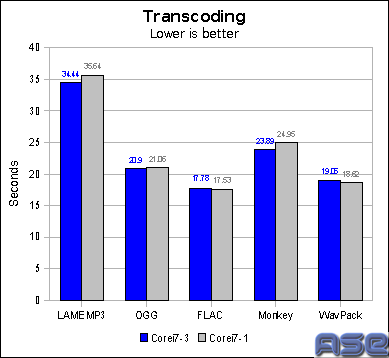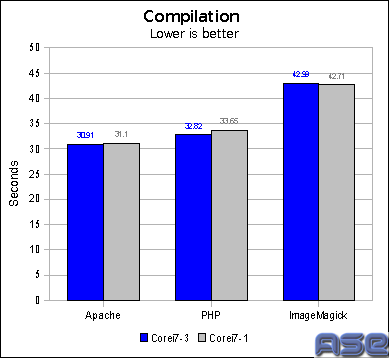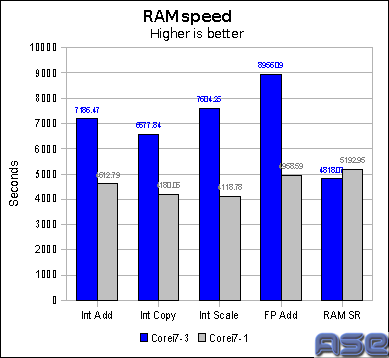Page All: Viewing All Pages
Page 1
Intro:
When Intel released their Core i7 CPU and the platform that enabled its use, it brought about a few new technologies that haven't been seen on the Intel side of things. One of them is the QPI or Quick Path Interconnect. Intel, being the king of "not invented here" syndrome, couldn't accept AMD's Hypertransport point to point high speed data bus. QPI is basically the same thing as Hypertransport and Intel has finally moved the memory controller onto the CPU die. No longer is there a FSB (sort of) that communicates with different components and the CPU. Along the same line, Intel moved to include triple channel memory support in its latest chipset, the X58. Do we really need triple channel and the added expense? This article hopes to shed some light on how triple channel interleaved memory compares with the same setup in single channel.
The DX58SO:
The motherboard being used is an Intel DX58SO known as the "Smackover." It doesn't have the same ring to it as the Bad Axe or Bonetrail/Skulltrail, but it is a new generation of product and this is the Intel extreme board. Other manufactures have taken the X58 chipset and made boards for all ends of the spectrum. The DX58SO represents a stable reference platform for use with the new Core i7 platform.
Since the northbridge no longer handles the CPU-Memory communication on Intel boards, each motherboard married to the same CPU should have similar performance for the memory subsystem unless the board manufacture added tweaks. Regardless, any board with the same CPU should give roughly the same performance.
The Core i7 920:
The CPU being used is the Core i7 920. It is a quad core processor running at 2.66GHz. Making a debut from the extreme series of CPUs is hyper-threading. Hyper-threading was very useful in the old P4 days when the CPU had resources not being used and dual core was not even on the cusp of coming out. These days, dual core CPUs are more than able to handle loads given by the majority of systems. No longer do systems freeze when doing a virus scan or other intensive process (if only they could do something about I/O transfers). On a quad core setup, hyper-threading seems to be overkill.
Kingston's Triple Channel Memory:
The memory being used will be the Kingston 3GB triple channel memory kit specifically designed for use with the Core i7 platform. The memory is rated for 1600MHz, but we opted to run it at the normal JEDEC speed of 1067MHz for this specific article. We are concerned with how the memory channel interleaving affects performance regardless of the speed and running it faster would hide the benefits. That is, if there are benefits at all. Triple channel memory kits are coming out in 3GB and 6GB kits. The 6GB kit will push you over the edge into 64-bit OS's. Linux and others like it have no problem and Windows seems to be puttering along with a few 64-bit versions as well. You'll find caveats when running 64-bit OS's. Some programs won't work and some drivers won't work. This goes for all OS's.
The Rest:
The OS being used will be Ubuntu 8.10 freshly installed with no updates on a 80GB Maxtor SATA hard drive. A Radeon 4850 was used with the fglrx binary driver from the repositories. ASE Labs is proud to say it will start using the Phoronix Test Suite in aiding to write articles and reviews. Michael at Phoronix has always been a proponent of open source software and it is good to use software that is well written (and open source as well!). We will be doing our own graphing, of course. If you use a POSIX style OS, you should give the Phoronix Test Suite a shot. I'm sure there will be a GUI built for it some day. Right now it is command line only, but it more than gets the job done.
Intro:
When Intel released their Core i7 CPU and the platform that enabled its use, it brought about a few new technologies that haven't been seen on the Intel side of things. One of them is the QPI or Quick Path Interconnect. Intel, being the king of "not invented here" syndrome, couldn't accept AMD's Hypertransport point to point high speed data bus. QPI is basically the same thing as Hypertransport and Intel has finally moved the memory controller onto the CPU die. No longer is there a FSB (sort of) that communicates with different components and the CPU. Along the same line, Intel moved to include triple channel memory support in its latest chipset, the X58. Do we really need triple channel and the added expense? This article hopes to shed some light on how triple channel interleaved memory compares with the same setup in single channel.
The DX58SO:
The motherboard being used is an Intel DX58SO known as the "Smackover." It doesn't have the same ring to it as the Bad Axe or Bonetrail/Skulltrail, but it is a new generation of product and this is the Intel extreme board. Other manufactures have taken the X58 chipset and made boards for all ends of the spectrum. The DX58SO represents a stable reference platform for use with the new Core i7 platform.
Since the northbridge no longer handles the CPU-Memory communication on Intel boards, each motherboard married to the same CPU should have similar performance for the memory subsystem unless the board manufacture added tweaks. Regardless, any board with the same CPU should give roughly the same performance.
The Core i7 920:
The CPU being used is the Core i7 920. It is a quad core processor running at 2.66GHz. Making a debut from the extreme series of CPUs is hyper-threading. Hyper-threading was very useful in the old P4 days when the CPU had resources not being used and dual core was not even on the cusp of coming out. These days, dual core CPUs are more than able to handle loads given by the majority of systems. No longer do systems freeze when doing a virus scan or other intensive process (if only they could do something about I/O transfers). On a quad core setup, hyper-threading seems to be overkill.
Kingston's Triple Channel Memory:
The memory being used will be the Kingston 3GB triple channel memory kit specifically designed for use with the Core i7 platform. The memory is rated for 1600MHz, but we opted to run it at the normal JEDEC speed of 1067MHz for this specific article. We are concerned with how the memory channel interleaving affects performance regardless of the speed and running it faster would hide the benefits. That is, if there are benefits at all. Triple channel memory kits are coming out in 3GB and 6GB kits. The 6GB kit will push you over the edge into 64-bit OS's. Linux and others like it have no problem and Windows seems to be puttering along with a few 64-bit versions as well. You'll find caveats when running 64-bit OS's. Some programs won't work and some drivers won't work. This goes for all OS's.
The Rest:
The OS being used will be Ubuntu 8.10 freshly installed with no updates on a 80GB Maxtor SATA hard drive. A Radeon 4850 was used with the fglrx binary driver from the repositories. ASE Labs is proud to say it will start using the Phoronix Test Suite in aiding to write articles and reviews. Michael at Phoronix has always been a proponent of open source software and it is good to use software that is well written (and open source as well!). We will be doing our own graphing, of course. If you use a POSIX style OS, you should give the Phoronix Test Suite a shot. I'm sure there will be a GUI built for it some day. Right now it is command line only, but it more than gets the job done.
Page 2
Results:
We will be focusing on real world testing. Compilation and transcoding test suites were used for the real world benchmarking. RAMspeed was used for a highly synthetic test. You will see the big difference in how synthetic tests can really skew results. What we will focus on is how triple channel can improve your overall speed. In all graphs, the blue indicates the triple channel while the gray is the single channel.
First up are the transcoding tests. Well, these are more or less regular encoding tests since they take a raw wav file and encode it to some compressed type of file. The triple channel performance overall is slightly better in most tests. In these tests, lower is better. Take these results at face value, you probably won't see many gains unless you are doing a load of encoding. Video compression should be faster, though. If you are a video editor, triple channel should help you out overall.
Next up are the compilation tests. In this case, the triple channel is still slightly faster than the single channel in all but one test. We are still in the statistical margin of error for these tests. What can be taken from these results is that spread overall, triple channel will give a slight boost.
As for the synthetic tests, triple channel easily beats the single channel in all but one test. The difference in this synthetic test is very high compared to the range of the previous real world tests. This is part of the reason that ASE Labs really focuses only on real world performance.
Conclusion:
While we can take away that triple channel has some advantage in real world use, it is not always the case that we'll be able to see or notice the performance increase. It is logical that the RAMspeed tests would show a high margin of difference for the most part since it is a synthetic test. On the real world tests, the picture is a bit different. We see that at times the triple channel loses by a hair to the single channel setup. All things being equal, the performance difference is negligible.
That doesn't mean that triple or even dual channel is a waste. I/O transfers are a huge bottleneck in computing power. Anything that can be done to increase the speed of I/O is helpful. There was a minor performance increase in triple channel over the entire test range and it is good to see when technologies work. We can probably assume that triple channel memory is here to stay and when later motherboard are released, it should only get better and better. Regardless, anything dealing with memory intensive applications will see a marginal benefit using triple channel. We are in interesting times once again in computing and it is good to see new developments happening.
Results:
We will be focusing on real world testing. Compilation and transcoding test suites were used for the real world benchmarking. RAMspeed was used for a highly synthetic test. You will see the big difference in how synthetic tests can really skew results. What we will focus on is how triple channel can improve your overall speed. In all graphs, the blue indicates the triple channel while the gray is the single channel.
First up are the transcoding tests. Well, these are more or less regular encoding tests since they take a raw wav file and encode it to some compressed type of file. The triple channel performance overall is slightly better in most tests. In these tests, lower is better. Take these results at face value, you probably won't see many gains unless you are doing a load of encoding. Video compression should be faster, though. If you are a video editor, triple channel should help you out overall.
Next up are the compilation tests. In this case, the triple channel is still slightly faster than the single channel in all but one test. We are still in the statistical margin of error for these tests. What can be taken from these results is that spread overall, triple channel will give a slight boost.
As for the synthetic tests, triple channel easily beats the single channel in all but one test. The difference in this synthetic test is very high compared to the range of the previous real world tests. This is part of the reason that ASE Labs really focuses only on real world performance.
Conclusion:
While we can take away that triple channel has some advantage in real world use, it is not always the case that we'll be able to see or notice the performance increase. It is logical that the RAMspeed tests would show a high margin of difference for the most part since it is a synthetic test. On the real world tests, the picture is a bit different. We see that at times the triple channel loses by a hair to the single channel setup. All things being equal, the performance difference is negligible.
That doesn't mean that triple or even dual channel is a waste. I/O transfers are a huge bottleneck in computing power. Anything that can be done to increase the speed of I/O is helpful. There was a minor performance increase in triple channel over the entire test range and it is good to see when technologies work. We can probably assume that triple channel memory is here to stay and when later motherboard are released, it should only get better and better. Regardless, anything dealing with memory intensive applications will see a marginal benefit using triple channel. We are in interesting times once again in computing and it is good to see new developments happening.






